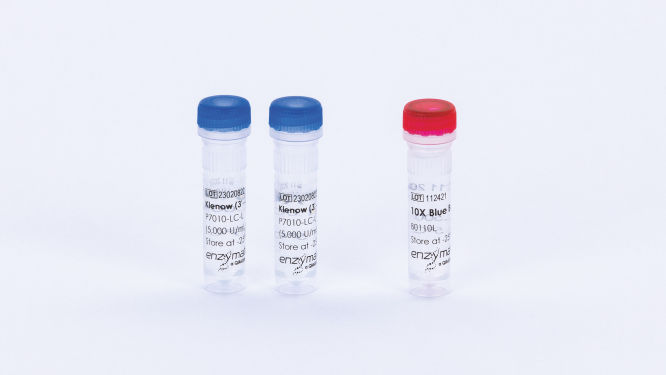Cat. No. / ID: P7010-LC-L
Features
- DNA polymerase lacking proofreading (3'→5') and nick-translation (3'→5') activities
- Retains robust 3'→5' DNA polymerase activity
- Used in fluorescent labeling reactions for microarray
- Best for dA and dT tailing for adapter ligation to DNA fragments for next-gen sequencing
Product Details
Klenow Fragment (3'→5' exo-) is the large fragment of DNA polymerase I (Klenow Fragment) that has been rendered deficient in both proofreading (3'→5') and nick-translation (3'→5') nuclease activities. Klenow Fragment (3'→5' exo-) is a mesophilic DNA polymerase that displays a moderate strand displacement activity during DNA synthesis.
The enzyme is supplied in 20 mM Tris-HCl, 1 mM DTT, 0.1 mM EDTA, 50% glycerol pH 7.5 @ 25⁰C.
The enzyme is supplied with 10X Blue Buffer (B0110) containing 500 mM NaCl, 100 mM Tris-HCl, 100 mM MgCl2, 10 mM DTT; pH 7.9 at 25°C.
Performance
| Assay | Specification |
| Purity | >99% |
| Specific activity | 10,000 U/mg |
| Single-stranded exonuclease | 500 U <10% released |
| Double-stranded exonuclease | 500 U <1% released |
| Double-stranded endonuclease | 500 U = No conversion |
| E. coli DNA contamination | 500 U <10 copies |
| UDG activity | <20 U/mL |
Principle
DNA polymerase I is a single polypeptide chain consisting of ∼930 residues. The holoenzyme possesses three activities: 5'→3' DNA-dependent DNA polymerase, 3'→5' proofreading and 3'→5' exonuclease (also known as flap endonuclease).
The 5'→3' exonuclease activity of E. coli DNA polymerase I makes it unsuitable for some applications. The main duty of the 5'→3' exonuclease activity is to remove the RNA primers at the 5' ends of newly synthesized DNA so that the polymerase activity can fill in the resulting gaps. The 3'→5' nuclease activity is used during DNA repair and is necessary for enzyme applications such as nick translation. It is undesirable for DNA sequencing and other applications due to the ability of the 5’→3’ exonuclease to degrade flap structures, single-stranded and double-stranded DNA from free 53'→5'-ends. The Klenow Fragment of E. coli DNA polymerase I lacks this 5’-exonuclease activity but retains the 5'→3' polymerase activity and the 3'→5' exonuclease activity for removal of precoding nucleotides and proofreading.
Just as the 5'→3' exonuclease activity of E. coli DNA polymerase I can be undesirable, the 3'→5' exonuclease proofreading activity of Klenow Fragment can also be undesirable in some circumstances. This problem is overcome by introducing mutations that result in the Klenow Fragment (3'→5' exo-) enzyme that retains 5'→3' polymerase activity but lacks any exonuclease activity. DNA polymerases lacking a 3'→5' exonuclease may add a single nontemplate-dependent nucleotide to the 3'-end of a sequence (tailing) with a preference for dATP depending on the reaction conditions and sequence context.
This process of dA-tailing (or dT-tailing) of the DNA is an important step in the process of ligating DNA adapters to DNA fragments. This procedure is frequently used in preparing DNA libraries for next-generation sequencing. The action of Klenow Fragment (3'→5' exo-) is also utilized in some fluorescent labeling reactions for microarray.
Procedure
Instructions for using Klenow Fragment (3'→5' exo-) are provided in the corresponding kit protocol in the resources below.
Quality Control
Klenow Fragment (3'→5' exo-) unit activity was measured using a 2-fold serial dilution method. Dilutions of enzyme were made in a glycerol (50%) containing Klenow (3'→5' exo-) storage solution and added to 50 μL reactions containing Calf Thymus DNA, 1X Blue Buffer, 3H-dTTP and 100 μM dNTPs. Reactions were incubated for 10 minutes at 37°C, plunged on ice, and analyzed using the method of Sambrook and Russell (Molecular Cloning, v3, 2001, pp. A8.25-A8.26).
Protein concentration of Klenow Fragment (3'→5' exo-) (OD280) was determined by OD280 absorbance.
Klenow Fragment (3'→5' exo-) physical purity was evaluated by SDS-PAGE of concentrated and diluted enzyme solutions followed by silver stain detection. Purity was assessed by comparing the aggregate mass of contaminant bands in the concentrated sample to the mass of the protein of interest band in the diluted sample.
Single-stranded exonuclease activity in Klenow Fragment (3'→5' exo-) was determined in a 50 μL reaction containing a radiolabeled single-stranded DNA substrate and 10 μL of enzyme solution incubated for 4 hours at 37°C.
Double-stranded exonuclease activity in Klenow Fragment (3'→5' exo-) was determined in a 50 μL reaction containing a radiolabeled double-stranded DNA substrate and 10 μL of enzyme solution incubated for 4 hours at 37°C.
Double-stranded endonuclease activity in Klenow Fragment (3'→5' exo-) enzyme was determined in a 50 μL reaction containing 0.5 μg of plasmid DNA and 10 μL of enzyme solution incubated for 4 hours at 37°C.
E. coli contamination of Klenow Fragment (3'→5' exo-) was evaluated using 5 μL replicate samples of enzyme solution denatured and screened in a TaqMan qPCR assay for the presence of contaminating E. coli genomic DNA using oligonucleotide primers corresponding to the 16S rRNA locus.
Uracil DNA glycosylase (UDG) contamination of Klenow Fragment (3'→5' exo-) was assessed in a 50 μL reaction containing tritiated uracil DNA and 10 μL enzyme solution incubated for 60 minutes at 37°C under standard UDG unit characterization conditions.
Applications
This product is available for molecular biology applications such as:
- Principal applications
- Proven choice for DNA labeling
- dA-tailing and dT-tailing for next-generation sequencing adapter ligation
- Other applications
- Dideoxy DNA sequencing of single or double-stranded DNA templates
- cDNA second strand synthesis
- Generation of single stranded DNA probes using random primers
- Site directed DNA mutagenesis using synthetic oligonucleotides

